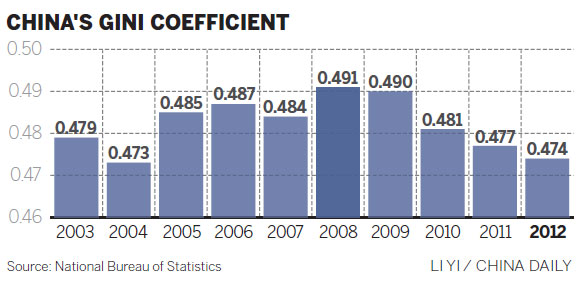Index shows wealth gap at alarming level
By Wei Tian in Boao, Hainan (China Daily) Updated: 2013-01-19 09:27Experts suggest social equality has been sacrificed for growth
An index that monitors the gap between the rich and poor has reached what experts consider an alarming level in China.
The Gini coefficient hit 0.474 in China in 2012, higher than the warning level of 0.4 set by the United Nations, the National Bureau of Statistics said on Friday.
|
 |
|
A beggar, with a feather duster in hand, loiters among heavy traffic in Beijing, offering "cleaning services" in exchange for money. China's miraculous economic growth in past decades has left an increasing number of people behind financially. Mao Yanzheng / China Daily |
But there are still doubts whether the index has accurately reflected the widening social disparity in the country.
According to data provided by the bureau, China's Gini coefficient has been retreating gradually from a peak level of 0.491 in 2008, Ma Jiantang, China's top statistics official, told a press conference in Beijing.
The Gini coefficient ranges from 0, which represents perfect equality, to 1, for absolute inequality.
The index stood at 0.473 in 2004, but after the financial crisis in 2008, it gradually dropped from its peak of 0.491 that year "as the government took measures to bring benefits for its people", Ma said.
"But China's Gini coefficient, between 0.47 and 0.49 during the past decade, was still relatively high, indicating the country must accelerate its income distribution reform to narrow the rich-poor gap," he said.
The Gini coefficient provided by the NBS presented a similar trend to that provided by the World Bank, but was much lower than a result from a private survey by Chengdu's Southwestern University of Finance and Economics published last December, which put the country's Gini coefficient at 0.61 in 2010, which prompted a huge reaction among netizens.
Commenting on the disparity, Ma said both official data and private surveys are "part of the statistics system, and serious private surveys should be an important and good supplement to government data".
He said the official figure was calculated using a new approach to review statistics tracked back to 2003.

Call for fairer income distribution
Wealth gap greatest challenge for China's growth
Wealth gap in rural China nears warning level
China to solve wealth distribution issues in 10 yrs
Raising income tops public concerns in 2012
Wealth gap 'widely felt' in China
- Index of rich-poor gap remains at warning level
- Call for fairer income distribution
- Wealth gap greatest challenge for China's growth
- Wealth gap in rural China nears warning level
- China to solve wealth distribution issues in 10 yrs
- Raising income tops public concerns in 2012
- Wealth gap 'widely felt' in China
- China marks new path for global economy, politics at G20 summit: Mexican expert
- China's investment in Belt and Road countries up 38.6%
- China Motor City sets up fund developing hydrogen energy vehicles
- Italian company plans global merchandise trading center in Jiangsu
- LeEco defines new era in internet ecosystem
- China state-owned non-ferrous metals group declared bankrupt
- World's most inventive modes of transport
- Chinese premier says frictions in China-US economic ties are normal

















